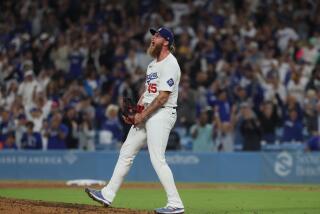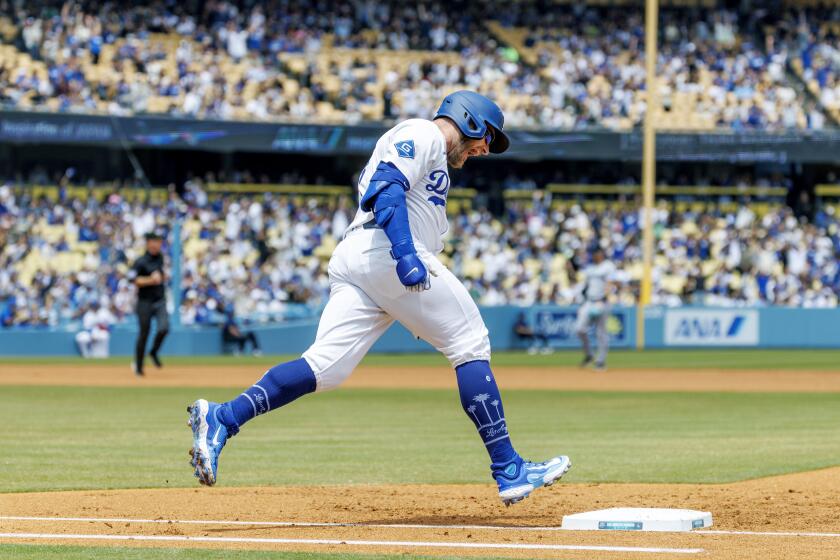STRAIGHTENING OUT : Hamilton Finally Learning to Hit Curve, Making Himself at Home on Third
- Share via
CINCINNATI — You can see some unusual sights during the informality of spring training. In time, most of the incidents fade from memory. But it is late June, and Jeff Hamilton’s meeting with Dodger Manager Tom Lasorda last spring at the Dodgertown complex in Vero Beach, Fla., can still draw a guffaw from anyone who witnessed it.
As he awaited the first Dodger players scheduled to report to camp, Lasorda soaked in a whirlpool. Hamilton walked into the clubhouse, carrying his bags.
Lasorda, quickly ended his conversation with reporters, rose from the swirling water and delivered the kind of motivational speech for which he charges corporate America vast sums--in his birthday suit.
He told Hamilton the story of Wes Parker, who, Lasorda said, he helped develop into a quality major league hitter.
He said that he would be in the Hall of Fame today, if only he would have had Hamilton’s ability to go with his own motivation.
“You stick with me,” Lasorda said, yelling and pointing. “I’ll take you to the big leagues.”
Hamilton, touted for several seasons as the Dodgers’ top prospect at third base, has stuck by Lasorda even after expressing doubts throughout spring training and finally is starting to perform close to Lasorda’s expectations.
After an uncertain spring, in which he even resorted to making a vague trade request, Hamilton made the major league roster as a late-inning defensive replacement for Pedro Guerrero. And, now that Guerrero is out indefinitely with a pinched nerve in his neck, Hamilton is the Dodgers’ third baseman.
In the 26 games Hamilton has started at third base this season, he has hit a respectable .281 and has driven in 19 runs. More impressive, heading into tonight’s Dodger game against the Cincinnati Reds at Riverfront Stadium, Hamilton is hitting .375 over the last two weeks. He also has made several excellent defensive plays.
Upon Guerrero’s return, Hamilton, 24, most likely will remain at third base, with Guerrero shifting to first since Mike Marshall has shifted to right field.
Hamilton, whose introverted nature often is misread as apathy, said he is heartened by the way things have evolved but is also a little wary about making too much of his sudden upward mobility.
“You can become content in this situation, now that I’m starting and all,” Hamilton said. “I don’t want to be contented. That can be a bad thing sometimes.”
What Hamilton seems to mean is that he will not take anything for granted. Sure, he may have proven over a stretch that he can hit major league curveballs--the big question in Lasorda’s mind--and that he can help stabilize the infield, but he approaches each day as another test.
“So far, yeah, I’m playing pretty good,” Hamilton said. “But I can’t settle for what I’ve been doing. Regardless of what (management) decides when Pete gets back, I’ve got to shoot for doing better than I’m doing.
“I don’t want to be too complacent. There’s no time to be happy now. I can wait to the end of the season to be happy. The great thing about playing every day is that you can strive to improve every day and redeem yourself the next night if you don’t.”
Perhaps Hamilton is cautious because his major league career has had several false starts. In 1986, at 22, Hamilton was recalled from triple-A in Albuquerque, N.M., to replace the injured Bill Madlock at third base. But he hit only .224 in 71 games and management was criticized by some for rushing the club’s top prospect.
Last season, Hamilton was leading the Pacific Coast League in hitting with a .360 average when he was recalled after Madlock was released in late May. But he played sparingly, hit poorly, and was returned to Albuquerque in July. He returned in early August when infielder Franklin Stubbs was put on the disabled list.
Hamilton was given what was supposed to be a real shot at winning the job during that second stint. Lasorda said that Hamilton would be the Dodgers’ third baseman the last two months of the season, which would have been the consistent playing time Hamilton was seeking.
But Hamilton sprained his left ankle six days after his recall and sat out the rest of the season.
Only now has Hamilton been able to take advantage of a chance to play regularly. He says it is responsible for his improved hitting and better overall play.
Lasorda, on the other hand, credits the extra time he spent with Hamilton during spring training, teaching him to hit curveballs and trying to bolster his confidence.
Said Hamilton, explaining his previous failures: “When you don’t get the starts consistently, you feel a lot more pressure when you do start. You wonder, ‘If I don’t get a hit, will he put the other guy in the lineup the next day?’ It’s hard to concentrate that way.
“I’m used to being an everyday player, like in the minors. And when you suddenly aren’t playing every day, your body reacts. You have a pattern when you’re playing, but then you stop the pattern. I like things as simple as possible. I don’t like complications. Everyone wants to have a steady role.”
Lasorda has said that Hamilton never will be a quality player if he does not learn to hit major league pitching, which means hitting curveballs.
“He’s come a long way,” Lasorda said. “You saw what happened in the spring. I thought he’d have a problem hitting big league pitching. So, I fed him curveballs every day in extra batting practice. You’ve seen what he’s done now. He has the capabilities.”
Lasorda, however, has occasional doubts as to whether Hamilton believes in his ability.
“Sometimes, he’s his own worst enemy,” Lasorda said. “I don’t find him hard to motivate. He just has a tendency to get down on himself at times.”
Hamilton admits that hitting curveballs has been a problem. But his confidence, he said, never has wavered.
“In the minor leagues, I was hitting the curves fine,” Hamilton said. “The difference is, when you get here, you see better curves and more of them. They’ll throw you a lot of curves until you start hitting them a little. I’ve done that. I know I can hit curveballs.”
And, about Lasorda’s contention that he lacks confidence?
“I’ve never not had confidence,” Hamilton said. “It’s just that other people didn’t have confidence in me.”
Hamilton took it as a sign that the club lacked confidence in him when they did not give him the starting third base spot in spring training. First, they had him competing with Steve Sax at third. Then, Guerrero wiped out any competition by agreeing to play third base so that Lasorda could use what he believed was his most productive batting order.
Hamilton suffered fits of depression during spring training, saying that he could bear neither a return ticket to Albuquerque nor a reserved seat on the Dodger bench as Guerrero’s understudy.
Eventually, Lasorda convinced Hamilton to accept his part-time role.
“I felt he would learn more here,” Lasorda said. “Learn more about the pitchers in the league. I also told him if someone in the infield got hurt, he’d probably be the guy. The same thing if Pete went back to first base.”
Said Hamilton: “I don’t like to think about the past and future. It’s easier just to look at where you are. I just want to forget about the spring.”
But has Hamilton forgotten about his encounter with Lasorda on the first day of spring training?
He smiled, just slightly, and said: “No.”
More to Read
Are you a true-blue fan?
Get our Dodgers Dugout newsletter for insights, news and much more.
You may occasionally receive promotional content from the Los Angeles Times.










